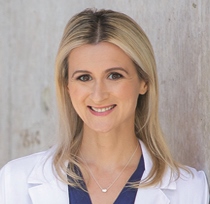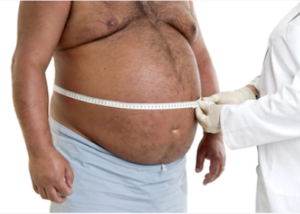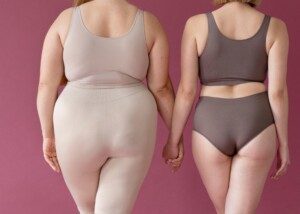
“Thin people can be unhealthy” is a mantra by some influencers in the body positivity movement.
But it’s true: Thin people do get heart bypass surgery.
A trim, slim man or woman can need coronary artery bypass surgery (also known as CABG: coronary artery bypass grafting).
But is this because their slenderness caused the plaque to build up in their heart’s arteries, narrowing them so much that they need a bypass?
Obesity, particularly morbid, is a well-proven risk factor and cause – and an enormous one – for coronary artery disease (CAD).
But is being skinny, lean or lanky – call it what you will – also an actual risk factor or cause of CAD?

Credit: BruceBlaus
“There are various risk factors that lead to coronary disease,” says Alexandra Kharazi, MD, a cardiothoracic surgeon with CVTS Medical Group, Inc., Chula Vista, CA.
There’s well over a dozen risk factors for CAD – many that may surprise you.
For instance, untreated obstructive sleep apnea, poor sleeping habits even without sleep apnea, and cocaine use are just three of them.
A person who’s thin “may still be hypertensive or a smoker, or perhaps have a family history,” continues Dr. Kharazi.
Thinness doesn’t get you off the hook for plaque buildup in your arteries.
However, obesity, in the presence of other CAD risk factors, drives up the odds of one day needing coronary bypass surgery or having a heart attack.
Ideally, you’ll want to have as few risk factors for CAD as possible. Some you can’t control such as family history and older age.
But others you can, such as obesity, a high sodium diet, smoking and a sedentary lifestyle.
“I definitely agree that thinness is not a risk factor for CAD,” says Dr. Kharazi.
And for the purpose of this article, “thin” refers to someone who has a slim or slender build, not someone who appears to have anorexia nervosa or is “wasted away.”
In fact, in this day and age of “fat activism,” and obesity promotion and celebration on TikTok and Instagram, a woman who’s 5’6 and 130 pounds is often called “skinny” or “thin.”
But that’s like saying someone who’s only 20 pounds overweight is “fat.”
A truly thin or skinny woman at 5’6 would weigh no more than 115 pounds.
We can banter all day long what the cutoff weight is that makes someone appear “skinny” or “thin,” but certainly, to call a 130 pounds on a 5’6 frame “thin” or “skinny” is carrying it a bit too far. A more accurate descriptor is slim or slender.
But in today’s climate of social media, even at 140 pounds she might still be regarded as “thin,” simply because the rate of morbid obesity among Americans has skyrocketed – and all that promotion on social media is actually – and very unfortunately – making a difference in peoples’ perception of what makes a body “skinny” or “thin.”
Thin People Get Coronary Artery Disease and Often Need CABG
Though the absence of obesity means the removal of one significant risk factor for CAD, “it does not mean that thin people can have a disproportionate amount of other risk factors which lead to CAD [and get away with it],” explains Dr. Kharazi.
“For example, if someone is a smoker and also has familial hyperlipidemia [high blood fat], they would likely be at higher risk for CAD than the general population.
“However, so would someone who is obese in the absence of those risk factors.
“In that situation, it’s not the thinness that contributes to the CAD, but rather, it was a characteristic of someone with other risk factors that ended up with CAD due to the other risk factors.”
In short, when a thin person has to have coronary artery bypass surgery, the development of this pathology had nothing to do with their body weight.
Additional risk factors for CAD include lack of exercise, excessive sitting, excessive sleeping, high intake of ultra-processed foods (even if one is of normal body weight), diabetes and heavy drinking.
If a fat person has to have CABG, it’s a safe bet that their body weight definitely contributed to the pathology.

Credit: Jazz Guy from New Jersey/CC BY 2.0/Wikimedia Commons
But if they’ve also been a smoker, consumed high amounts of ultra-processed foods, never did any aerobic exercise, then these other factors, too, helped create disease in the coronary arteries.
It’s just that there’s no way to break down, percentage-wise, the precise contributions, such as, for example:
- Patient X’s morbid obesity contributed to 30% of her CAD.
- To put another way, morbid obesity is 30% responsible for X’s CAD, while her smoking is responsible for 30%; her lack of exercise is responsible for 20%; and her junk food diet is responsible for 20%.
There’s no way to determine such breakdowns. But we know that the three biggest, modifiable risk factors for CAD are obesity, smoking and avoidance of an exercise program.
It’s not realistic to believe that if a morbidly obese person has severe blockages in their heart’s arteries, that there’s actually a possibility that their weight had nothing to do with this!
It DID. We just don’t know how much it contributed when compared to any other risk factors that person might have had, such as high blood pressure and untreated sleep apnea.
But remember, several other risk factors for CAD can be caused by obesity, such as high blood pressure, OSA and type 2 diabetes!
Plus, a high sodium, ultra-processed diet almost always goes hand-in-hand with obesity.
With all that said, you should now clearly understand why thinness or a normal BMI or normal body fat percentage do not necessarily prevent coronary plaque buildup.
But if you have other risk factors, especially family history and being over 50, this is all the more reason to avoid or eliminate as many modifiable risk factors as possible – such as obesity and smoking – to LOWER your risk of suffering a cardiac event or needing stent placements or CABG.
 Dr. Kharazi has many areas of surgical expertise including the following: aortic aneurysm repair, aortic valve repair and replacement, and CABG. Other areas of focus include arrhythmia, bloodless medicine, lung cancer and resection, septal defect repair and thoracic surgery.
Dr. Kharazi has many areas of surgical expertise including the following: aortic aneurysm repair, aortic valve repair and replacement, and CABG. Other areas of focus include arrhythmia, bloodless medicine, lung cancer and resection, septal defect repair and thoracic surgery.
 Lorra Garrick has been covering medical, fitness and cybersecurity topics for many years, having written thousands of articles for print magazines and websites, including as a ghostwriter. She’s also a former ACE-certified personal trainer.
Lorra Garrick has been covering medical, fitness and cybersecurity topics for many years, having written thousands of articles for print magazines and websites, including as a ghostwriter. She’s also a former ACE-certified personal trainer.
.









































